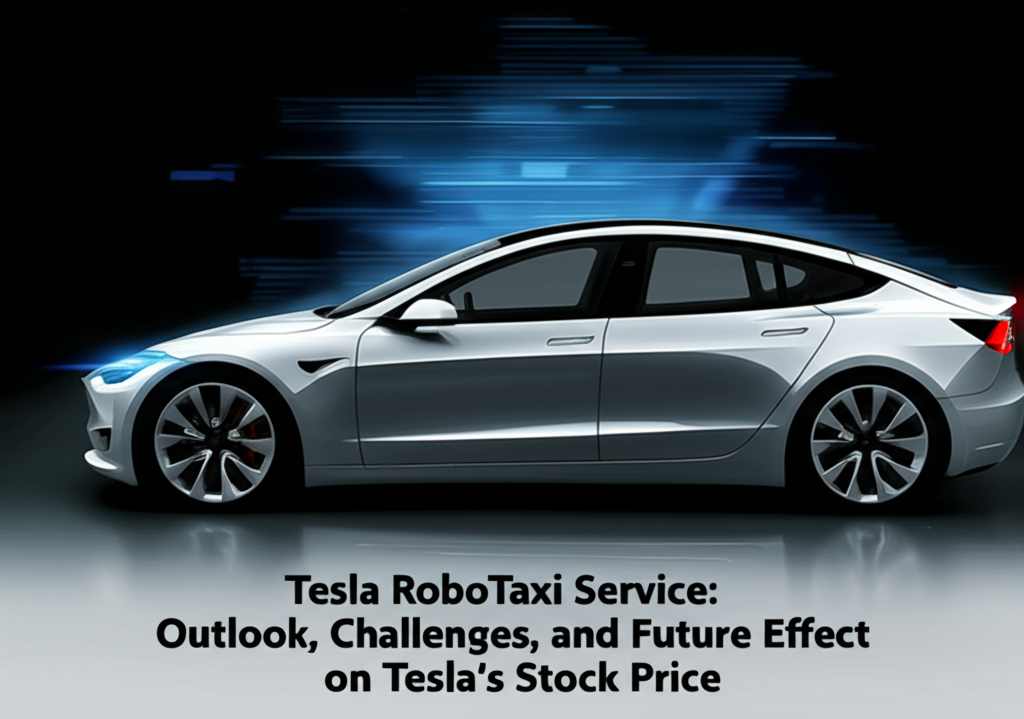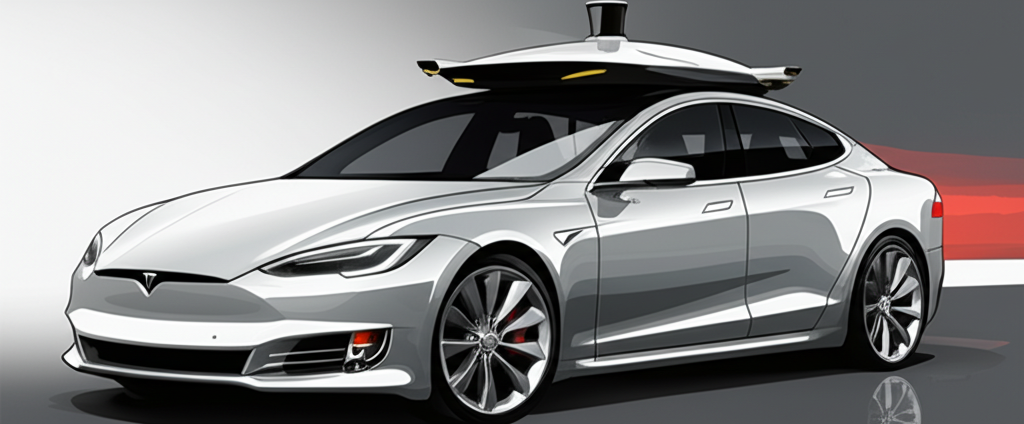
Tesla RoboTaxi Service: Outlook, Challenges, and Future Effect on Tesla’s Stock Price
Tesla stands on the verge of launching its autonomous ride-hailing service, promising a revolution in transportation. The company’s RoboTaxi initiative represents a fundamental shift in how we perceive transportation, with the potential to transform Tesla from a traditional automaker into a technology-driven mobility provider. However, several challenges must be addressed before this ambitious vision becomes reality.
Key findings indicate that while Tesla’s RoboTaxi service holds significant potential for long-term value creation, the company must overcome technological hurdles, navigate complex regulatory landscapes, and manage public perception. Safety data and deployment strategies will play crucial roles in ensuring the successful rollout of the service, which in turn will significantly impact Tesla’s stock price and future growth trajectory.
Introduction: The Dawn of Autonomous Transportation
The concept of self-driving vehicles has rapidly evolved from science fiction to tangible reality, with Tesla leading this transportation revolution under Elon Musk’s ambitious vision. Today, we stand on the cusp of a new era with the imminent launch of Tesla’s RoboTaxi service.
Imagine summoning a Tesla via an app, entering the vehicle, and being transported to your destination while you relax or work—all without a human driver. This isn’t just another product launch; it represents a fundamental shift in transportation paradigms, potentially disrupting traditional mobility services and reshaping urban landscapes.
Tesla’s approach to autonomous vehicles differs significantly from competitors. Rather than relying on expensive lidar technology and operating in limited geofenced areas, Tesla’s strategy leverages a vision-based system powered by neural networks that learn from millions of miles of real-world driving data. This approach aims to create a scalable solution capable of operating in diverse environments—from crowded city streets to open highways.
The company’s ambitious RoboTaxi plans include deploying a fleet of fully autonomous vehicles that can transport passengers without human intervention. The rollout will begin with the existing Tesla vehicle lineup equipped with Full Self-Driving (FSD) capabilities, followed by the introduction of a purpose-built “Cybercab” expected to enter production in 2026.
The Current State of Tesla’s Autonomous Technology
Tesla’s path to full autonomy has been marked by incremental improvements in its Autopilot and Full Self-Driving (FSD) systems. The company’s approach differs significantly from competitors, focusing on vision-based technology rather than relying on expensive lidar sensors.
Safety Performance Data
Safety remains the paramount concern in autonomous vehicle deployment. Tesla regularly publishes quarterly safety reports that provide insights into accident rates when Autopilot is engaged versus manual driving. These reports consistently show a lower crash rate per million miles driven when Autopilot is engaged.
Recent data from Q3 2024 indicates:
| Driving Mode | Crash Rate |
|---|---|
| With Autopilot | 1 crash per 7.08 million miles |
| Without Autopilot | 1 crash per 1.29 million miles |
| National Average | 1 crash per 670,000 miles |
This safety data serves as a foundation for Tesla’s argument that its autonomous technology is significantly safer than human drivers. However, critics argue that these statistics don’t account for the fact that Autopilot is primarily used in less complex driving environments, such as highways.
Full Self-Driving Beta Program
Tesla’s FSD Beta program has been gradually expanding, allowing selected customers to test more advanced autonomous features. The program has been crucial for gathering real-world data and improving the system through machine learning. As of early 2025, Tesla reports over 500 million miles driven with FSD Beta across various road conditions and environments.
The progression from driver assistance to full autonomy follows the SAE International classification system:
| Level | Name | Description | Tesla Status |
|---|---|---|---|
| 1 | Driver Assistance | System assists with steering OR acceleration/deceleration | Achieved |
| 2 | Partial Automation | System assists with steering AND acceleration/deceleration | Achieved |
| 3 | Conditional Automation | System drives but requires human oversight | In progress |
| 4 | High Automation | System drives without human oversight within specific conditions | Target for RoboTaxi |
| 5 | Full Automation | System drives in all conditions without human oversight | Future goal |
Tesla is currently operating between Levels 2 and 3, with the RoboTaxi service requiring Level 4 capabilities. The company aims to achieve this milestone by mid-2025, though many industry experts remain skeptical about this timeline.
RoboTaxi Deployment Plans and Market Strategy
Tesla has announced a phased deployment strategy for its RoboTaxi service, beginning with a limited rollout in specific regions before expanding nationwide.
Initial Launch and Expansion
The company plans to launch its RoboTaxi service in June 2025, starting in Austin, Texas. This strategic choice aligns with Tesla’s growing presence in the region, including its Gigafactory Texas. The initial fleet will be company-owned and supported by human teleoperators who can remotely assist vehicles if needed.
Following the Austin launch, Tesla aims to expand to California, where it has conducted extensive testing and developed relationships with regulators. The expansion timeline will depend on both technological readiness and regulatory approvals, with Tesla targeting coverage in major U.S. metropolitan areas by the end of 2026.
Revenue Model and Market Opportunity
Tesla’s RoboTaxi service represents a potential paradigm shift in the company’s business model, moving from selling vehicles to providing transportation as a service. This shift could dramatically increase the lifetime value of each vehicle manufactured.
According to industry analyses, autonomous ride-hailing services could generate revenue in several ways:
- Direct ride-hailing fees: Charging passengers for transportation services
- Subscription models: Monthly fees for unlimited or tiered access to the service
- In-vehicle advertising and entertainment: Monetizing passenger attention during rides
- Data monetization: Leveraging ride data for urban planning and other applications
The global autonomous vehicle market is projected to grow to approximately $115 billion by 2029, representing a significant opportunity for early movers like Tesla. The ride-hailing component alone is expected to reach $38 billion by 2027.
Tesla’s unique position as both a vehicle manufacturer and technology provider gives it potential advantages in scaling its RoboTaxi service more efficiently than competitors who must partner with traditional automakers.

Regulatory Landscape and Challenges
The regulatory environment for autonomous vehicles varies significantly across regions, creating a complex landscape for Tesla to navigate.
United States Regulatory Framework
In the U.S., autonomous vehicle regulation primarily occurs at the state level, resulting in a patchwork of different requirements. As of early 2025, over 30 states have enacted legislation related to autonomous vehicles, with varying degrees of permissiveness.
States like California, Arizona, and Texas have emerged as leaders in AV testing, establishing frameworks that allow companies to deploy vehicles with limited restrictions. However, federal guidelines from the National Highway Traffic Safety Administration (NHTSA) provide only voluntary standards, creating uncertainty for nationwide deployment.
Tesla’s strategy involves working closely with state regulators while advocating for federal legislation that would create uniform standards across the country. The company has established dedicated regulatory affairs teams to navigate this complex landscape.
International Considerations
Globally, regulatory approaches to autonomous vehicles vary even more widely. China has emerged as a leader in AV deployment, with a centralized regulatory system that has enabled rapid adoption. The Chinese market for self-driving taxis reached approximately $12 billion in 2024, compared to $8 billion in the U.S.
Europe has taken a more cautious approach, with stringent safety requirements and emphasis on ethics in AI decision-making. The EU’s regulatory framework requires extensive validation before permitting autonomous vehicles on public roads.
This regulatory diversity creates both challenges and opportunities for Tesla. While navigating different regulatory regimes adds complexity, it also allows the company to deploy strategically in regions with favorable regulatory environments while building evidence for safety in more restrictive markets.
Public Perception and Trust
The success of Tesla’s RoboTaxi service depends not only on technological and regulatory factors but also on public acceptance and trust.
Consumer Attitudes Toward Autonomous Vehicles
Public opinion surveys reveal a mixed picture regarding autonomous vehicles:
- In the U.S., approximately 71% of people remain skeptical about fully driverless taxis, citing safety concerns and a preference for human control.
- In contrast, over 85% of passengers in Chinese autonomous taxis reported positive experiences, indicating regional variations in acceptance.
- Recent high-profile incidents involving driver assistance systems have heightened public scrutiny, even when these systems function as designed with clear limitations.
Building trust will require Tesla to demonstrate consistent safety performance and transparency in reporting incidents. The company has used its quarterly safety reports as part of this effort, but more comprehensive disclosure may be necessary to convince skeptical consumers.
Media Coverage and Public Discourse
Media coverage of autonomous vehicles tends to amplify incidents and setbacks while giving less attention to incremental improvements and successful operations. This creates a challenging environment for building public confidence.
Tesla’s approach to media relations has sometimes exacerbated this issue, with Elon Musk’s public statements occasionally creating confusion about capabilities and timelines. A more measured communication strategy, focusing on realistic expectations and educational outreach, could help build sustainable public trust.
Potential Impact on Tesla’s Stock Price
Tesla’s stock price has long been influenced by the company’s perceived potential beyond traditional automotive manufacturing. The RoboTaxi initiative represents a significant component of this future value proposition.
Analyst Perspectives
Major financial analysts have incorporated Tesla’s RoboTaxi plans into their valuation models, with varying degrees of optimism:
- Morgan Stanley maintains a high price target based on the potential of “embodied AI,” which uses sensors to learn from the physical world.
- Wedbush’s Dan Ives believes Tesla’s FSD is in the final stages of readiness, supporting a bullish outlook.
- More conservative analysts point to declining vehicle deliveries in 2025 as a counterbalance to the RoboTaxi potential.
The consensus view suggests that successful deployment of RoboTaxi services could significantly increase Tesla’s valuation by opening new revenue streams and demonstrating leadership in AI and robotics.
Factors Influencing Stock Performance
Several key factors will influence how the RoboTaxi initiative affects Tesla’s stock price:
- Deployment Timeline: Meeting or missing announced deadlines will significantly impact investor confidence.
- Safety Performance: Any high-profile safety incidents could create substantial downside risk.
- Regulatory Approvals: Securing permissions in key markets will be necessary for scaled deployment.
- Competitive Dynamics: Advancements by competitors like Waymo could affect Tesla’s perceived leadership.
- Financial Performance: The capital requirements for RoboTaxi deployment versus the timeline to profitability.
The stock’s performance will likely remain volatile as these factors develop, with substantial upside potential if Tesla can successfully navigate the technological and regulatory challenges ahead.
Technological Challenges and Limitations
Despite Tesla’s optimistic projections, significant technological challenges remain on the path to full autonomy.
The Edge Case Problem
One of the most significant challenges in autonomous driving is handling “edge cases”—rare but critical scenarios that require sophisticated decision-making. These might include unusual road conditions, unexpected obstacles, or complex social interactions with pedestrians and other drivers.
Tesla’s approach relies on collecting data from its fleet of vehicles to identify and address these edge cases through neural network training. However, some experts question whether this approach can address all possible scenarios without resorting to explicit programming for certain situations.
Technical Infrastructure Requirements
Beyond the vehicle technology itself, a robust RoboTaxi service requires sophisticated backend infrastructure for fleet management, remote monitoring, and real-time decision support. Tesla has been developing these systems in parallel with its autonomous driving technology.
Key components include:
- Fleet management software for optimal vehicle routing and passenger matching
- Remote assistance capabilities for handling unusual situations
- High-speed, low-latency communications networks
- Secure software update mechanisms
- Redundant safety systems
The integration of these components presents its own set of engineering challenges, requiring expertise beyond Tesla’s traditional automotive focus.
Competitive Landscape
Tesla faces competition from both traditional automotive manufacturers and technology companies in the race to deploy autonomous ride-hailing services.
Key Competitors
The autonomous vehicle market includes several well-funded competitors with different approaches:
- Waymo: Alphabet’s autonomous driving unit has accumulated the most miles of fully autonomous driving and operates commercial services in limited areas. Waymo uses a more conservative approach with lidar-based systems and detailed mapping.
- Cruise: General Motors’ autonomous vehicle subsidiary has deployed robotaxis in San Francisco, though it has faced regulatory challenges after several incidents.
- Baidu: China’s tech giant operates Apollo Go, one of the world’s largest robotaxi services, benefiting from supportive regulations in China.
- Traditional automakers: Companies like Mercedes-Benz, BMW, and Ford are developing their own autonomous driving technologies, though generally taking more conservative approaches than Tesla.
Each competitor brings different strengths and limitations. Waymo and Cruise have demonstrated more mature technology in limited geographic areas, while Tesla’s approach potentially offers greater scalability if successfully developed.
Competitive Advantages and Disadvantages
Tesla’s competitive position includes several key advantages:
- Data advantage: Tesla’s fleet of vehicles provides vast amounts of real-world driving data for training AI systems.
- Vertical integration: Manufacturing both vehicles and autonomous technology allows Tesla to optimize the entire system.
- Brand loyalty: Tesla’s strong brand and enthusiastic customer base could drive early adoption.
However, Tesla also faces disadvantages:
- Technology approach: Relying primarily on cameras rather than lidar creates challenges in certain weather and lighting conditions.
- Regulatory scrutiny: Tesla’s approach to deploying technology iteratively has sometimes created friction with regulators.
- Public perception: High-profile incidents involving Autopilot have created skepticism about Tesla’s safety claims.
This competitive landscape will continue to evolve rapidly as technologies mature and regulatory frameworks develop.
Recommendations for Success
Based on the analysis of Tesla’s RoboTaxi service outlook and challenges, several strategic recommendations emerge for maximizing the potential benefits and mitigating risks:
Safety and Transparency
Tesla should implement a robust safety validation program that exceeds regulatory requirements and publish detailed, transparent safety data quarterly. This should include disengagement rates (when human intervention is needed) and near-miss incidents, not just accidents.
Building public trust requires demonstrating an unwavering commitment to safety through both technological improvements and transparent communication. A measurable goal would be achieving a 20% reduction in disengagement rates year-over-year for the first three years of RoboTaxi operation.
Phased Deployment Strategy
The planned limited, geofenced deployment in Austin should proceed as scheduled in June 2025, with expansion based strictly on real-world performance data and regulatory approvals. This cautious approach allows for iterative improvements while minimizing potential disruptions or safety incidents.
Success in the initial deployment should be measured by achieving 99.9% service uptime before expanding to a second city by Q1 2026. This disciplined approach may disappoint those hoping for rapid nationwide deployment but will build a more sustainable foundation for long-term success.
Regulatory Engagement
Tesla should establish a dedicated regulatory affairs team to actively engage with federal, state, and local authorities while participating in industry working groups to shape future regulations. Proactive engagement can help streamline the approval process and prevent costly delays.
The goal should be securing regulatory approvals for RoboTaxi operation in at least three additional states by the end of 2026, demonstrating momentum in regulatory acceptance.
Revenue Diversification
To improve financial viability, Tesla should explore partnerships with logistics companies and delivery services to leverage the RoboTaxi platform for goods transportation during off-peak hours. This diversification reduces reliance on passenger transport alone and could generate at least 15% of RoboTaxi revenue from non-passenger transport by the end of 2027.
Cybersecurity and Data Privacy
As autonomous vehicles become increasingly connected, Tesla must implement state-of-the-art cybersecurity measures to protect against hacking and data breaches. A comprehensive data privacy policy complying with all applicable regulations is essential for maintaining customer trust and avoiding legal liabilities.
Conclusion: The Road Ahead
As Tesla continues its journey toward deploying a full-scale RoboTaxi service, the road ahead contains both tremendous opportunities and significant challenges. The company’s ambitious vision for transforming transportation could reshape cities, reduce accidents, and create new economic models—while potentially driving Tesla’s stock price to new heights.
However, the path to this future requires navigating technological hurdles, complex regulatory landscapes, and evolving public perceptions. Success will demand not only technological innovation but also strategic patience, regulatory diplomacy, and transparent communication.
The coming years will reveal whether Tesla can deliver on Elon Musk’s vision of a world where autonomous vehicles transform our relationship with transportation. If successful, the RoboTaxi service could position Tesla not just as an innovative automaker but as a defining force in 21st-century mobility.
For investors, customers, and transportation planners alike, Tesla’s RoboTaxi initiative represents a pivotal moment worth watching closely. The revolution in autonomous transportation isn’t just coming—it’s already beginning, with Tesla determined to lead the way.
This article was compiled using research data and industry analysis as of March 2025. The rapidly evolving nature of autonomous vehicle technology and regulations means that new developments may alter the landscape described here.

